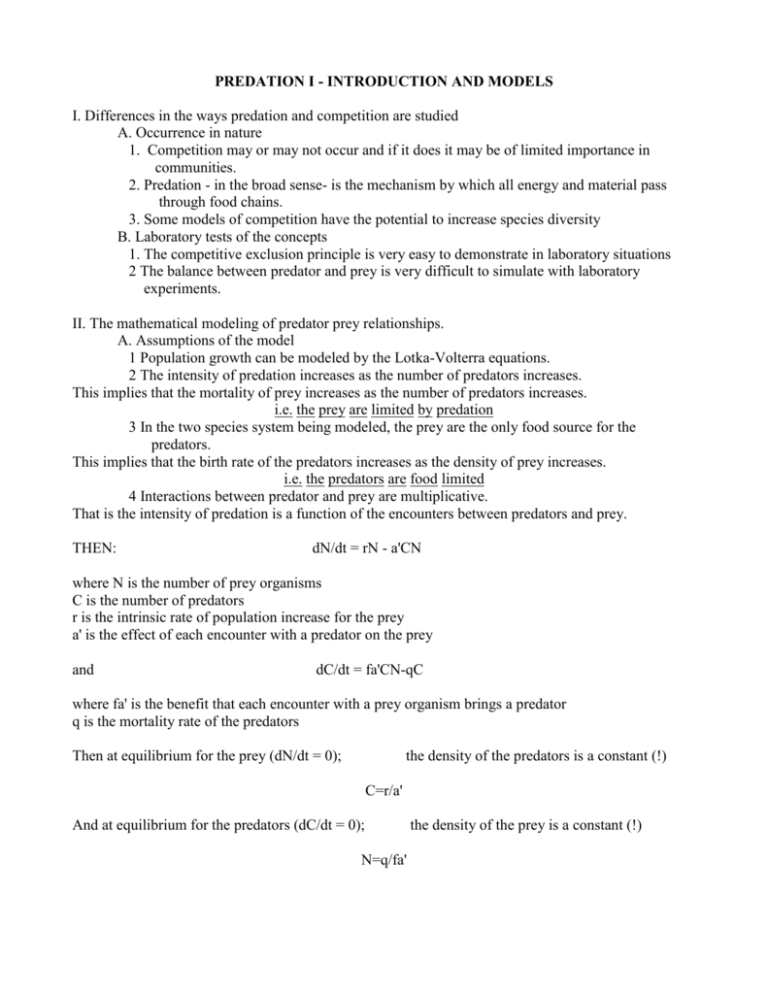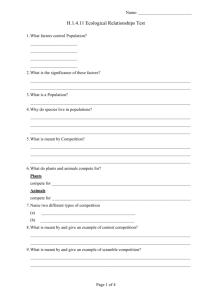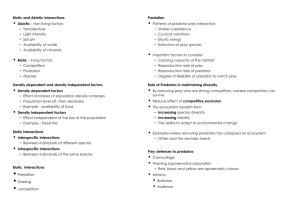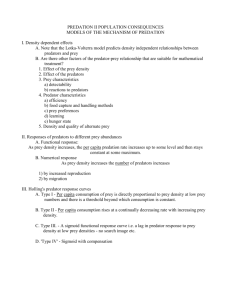PREDATION I - INTRODUCTION AND MODELS
advertisement

PREDATION I - INTRODUCTION AND MODELS I. Differences in the ways predation and competition are studied A. Occurrence in nature 1. Competition may or may not occur and if it does it may be of limited importance in communities. 2. Predation - in the broad sense- is the mechanism by which all energy and material pass through food chains. 3. Some models of competition have the potential to increase species diversity B. Laboratory tests of the concepts 1. The competitive exclusion principle is very easy to demonstrate in laboratory situations 2 The balance between predator and prey is very difficult to simulate with laboratory experiments. II. The mathematical modeling of predator prey relationships. A. Assumptions of the model 1 Population growth can be modeled by the Lotka-Volterra equations. 2 The intensity of predation increases as the number of predators increases. This implies that the mortality of prey increases as the number of predators increases. i.e. the prey are limited by predation 3 In the two species system being modeled, the prey are the only food source for the predators. This implies that the birth rate of the predators increases as the density of prey increases. i.e. the predators are food limited 4 Interactions between predator and prey are multiplicative. That is the intensity of predation is a function of the encounters between predators and prey. THEN: dN/dt = rN - a'CN where N is the number of prey organisms C is the number of predators r is the intrinsic rate of population increase for the prey a' is the effect of each encounter with a predator on the prey and dC/dt = fa'CN-qC where fa' is the benefit that each encounter with a prey organism brings a predator q is the mortality rate of the predators Then at equilibrium for the prey (dN/dt = 0); the density of the predators is a constant (!) C=r/a' And at equilibrium for the predators (dC/dt = 0); N=q/fa' the density of the prey is a constant (!) Bird & Kalff 1986 Bacterial grazing by planktonic lake algae. Science 231: 493-494. Craig, J. K, Burke, Brian J., Crowder, Larry B., Rice, James A. 2006: Prey growth and size-dependent predation in juvenile estuarine fishes: experimental and model analyses. Ecology: Vol. 87, No. 9, pp. 2366–2377. Gilg et al. 2003 Cyclic dynamics in a simple vertebrate predator-prey community Science 302: 866868. Lewin R. 1983. Predators and hurricanes change ecology Science 221: 737-740. Marquis R. 1984. Leqaf herbivores decrease fitness of a tropical plant Science 226: 537-539. Messier, F. 1994: Ungulate Population Models with Predation: A Case Study with the North American Moose. Ecology: Vol. 75, No. 2, pp. 478–488. Schmidt, K. A., Goheen, J. R., Naumann, R. 2001: Incidental nest predation in songbirds: behavioral indicators detect ecological scales and processes. Ecology: Vol. 82, No. 10, pp. 2937–2947. Schoener & Spiller 1995. Effect of predators and area on invasions: An experiment with island spiders. Science 267: 1811-1813. Terborgh et al. 2001 Ecological meltdown in predator-free forest fragments Science 294: 1923-1926. Seitz, R. D., Lipcius, R. N., Hines, A. H., Eggleston, D. B. 2001: Density-dependent predation, habitat variation, and the persistence of marine bivalve prey. Ecology: Vol. 82, No. 9, pp. 2435–2451. Vucetich, J. A., Peterson, R. O., Schaefer, C. L. 2002: The effect of prey and predator densities on wolf predation. Ecology: Vol. 83, No. 11, pp. 3003–3013.










